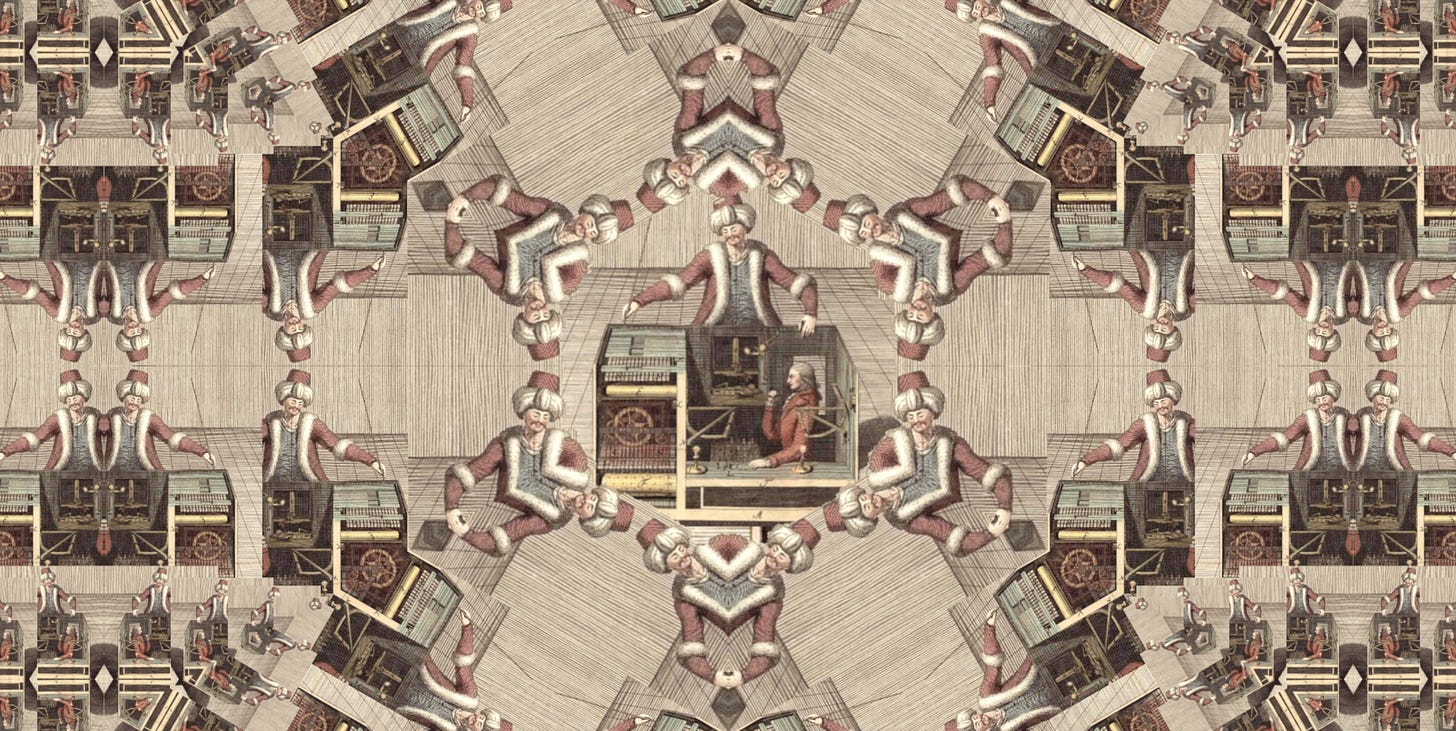Invasion of the Mechanical Turks
Invasion of the Mechanical Turks
How a notorious automaton foreshadowed the collapse of empirical science
“You tell me you can predict the world of 2100. Tell me it’s even worth thinking about. Our models just carry the present into the future. They’re bound to be wrong. Everybody who gives a moment’s thought knows it.”
- Michael Crichton
In 1770, Wolfgang von Kempelen unveiled his wonderous automaton, later dubbed ‘the Mechanical Turk’. A wooden man stood behind a cabinet upon which sat a chessboard. Kempelen showed the audience the elaborate mechanical gears controlling the movements of the mannikin, styled after an Ottoman magician. To the delight of the Hungarian monarch, Empress Maria Theresa, the device mechanically moved the chess pieces in response to a human player taking their turn at the board - and frequently defeated them! In 1783 at an exhibition in Paris, it beat Benjamin Franklin much to his astonishment, and although a Parisian grandmaster was able to secure victory, he was forced to admit it had been quite the challenge. It was the first evidence that machines could not only play chess, but do so at a level of performance above that of humans.
...except of course, it was no such thing, since the entire apparatus was an elaborate hoax. Inside the cabinet was a concealed human player who was secretly operating the magician’s hand via a series of pulleys who was following the game via their own copy of the board inside. The Mechanical Turk was indeed an engineering marvel... but the way it presented itself to its audiences was an elaborate deception.
Charles Babbage lost to the Mechanical Turk twice in 1819, and although sensing it was a fake he was far less interested in exposing it than he was inspired to make his Difference Engine, a mechanical computational device. This in turn inspired Lord Byron’s daughter, Ada Lovelace, to create her steam-powered programmable computer, the Analytical Engine. From these bold beginnings grew contemporary silicon chip computers. By the early years of the twenty first century, hardware was sufficiently potent, and programming skill so well distributed, that surprisingly complex simulations could be created on computers with comparative ease.
In 2002, six years before his death, the novelist Michael Crichton presented the James Michelin lecture at Caltech. Framed by the joyously absurd claim that “extraterrestrials lie behind global warming”, Crichton’s lecture began by exploring the infamous Drake Equation that purported to determine the chances of encountering extraterrestrial life using an equation with half a dozen terms. But as Crichton accused, not one of these terms can be measured. Rather, we bring our own prior prejudices into such models. With the advent of widespread calculative power, computer models have proliferated in the sciences, including widely-publicised scenarios for predicting nuclear winters, and soon after, global warming.
But as Crichton warned, the media programme invented by Carl Sagan and others to promote nuclear winter “is not the way science is done, it is the way products are sold”. Crichton perfectly understood the fascination with computer models, and cited Richard Feynmann’s comment that our seduction by these mathematical models was “a disease”. As the opening quote makes clear, Crichton was adamant that attempts to predict the future with such models were doomed, because all they could do was carry our own assumptions forward. Inevitably, whether with nuclear weapons or with environmentalism, computer models allow political commitments to manifest as if they were legitimate empirical science.
The Mechanical Turk has now had its revenge - the calculating devices it inspired are deployed for asserting political domination under the corrupted name of science. Yet computer models are not empirical evidence, they are at best hypotheses requiring robust evidence to prove or disprove their claims. Just as the original automaton hid a human inside who was pulling the levers, so each computer model has all the political prejudices of its makers concealed within its variables and subroutines.
Whether it is climate models that have stalled research into the effects of atmospheric carbon dioxide, or epidemiological models making absurd claims about infections for which even the mechanisms of transmission have not yet been adequately studied, we are witnessing the invasion of the Mechanical Turks. Scientific study is no longer a matter of empirical investigation and rigorous debate of the evidence, but merely an opportunity for smuggling desired assumptions into a convenient computer model. These disastrous new Mechanical Turks now serve to bully everyone into moving the political pieces to wherever the wooden magician’s hand moves.

Comments
Post a Comment